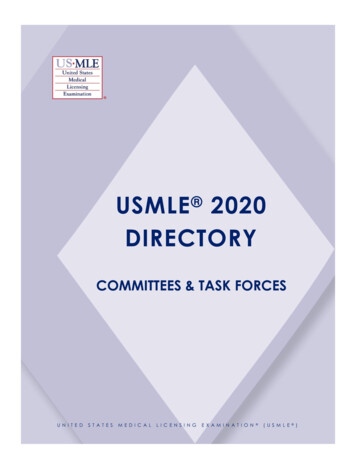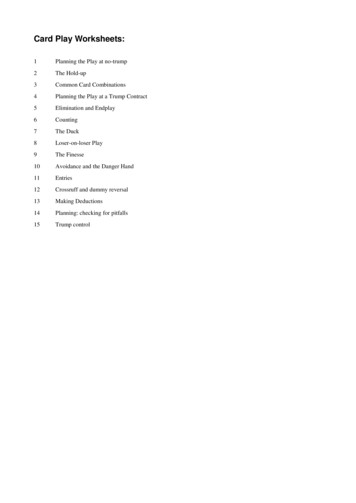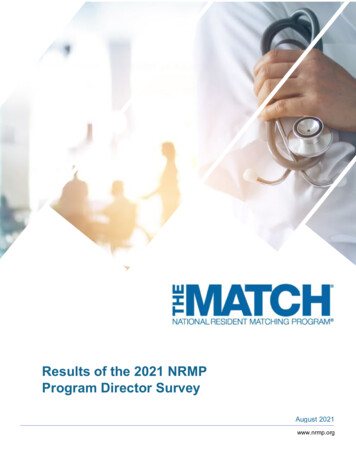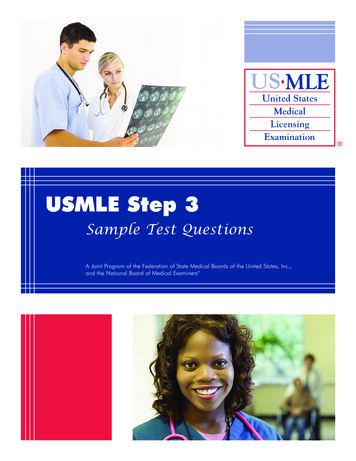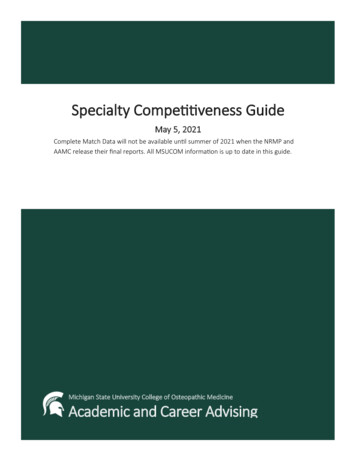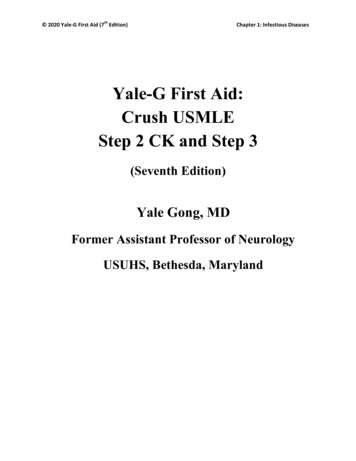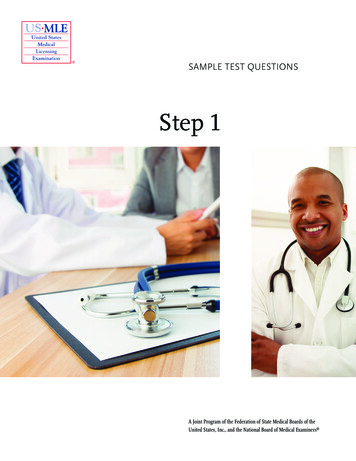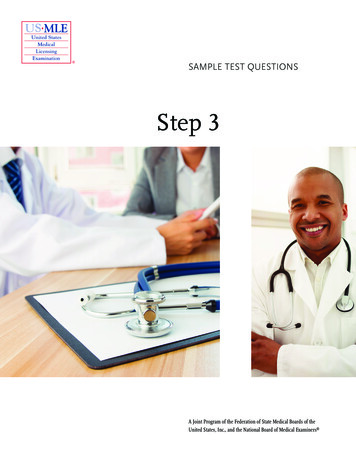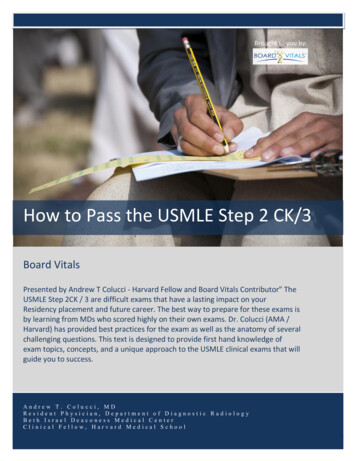
Transcription
Brought to you by:How to Pass the USMLE Step 2 CK/3Board VitalsPresented by Andrew T Colucci - Harvard Fellow and Board Vitals Contributor" TheUSMLE Step 2CK / 3 are difficult exams that have a lasting impact on yourResidency placement and future career. The best way to prepare for these exams isby learning from MDs who scored highly on their own exams. Dr. Colucci (AMA /Harvard) has provided best practices for the exam as well as the anatomy of severalchallenging questions. This text is designed to provide first hand knowledge ofexam topics, concepts, and a unique approach to the USMLE clinical exams that willguide you to success.Andrew T. Colucci, MDResident Physician, Department of Diagnostic RadiologyBeth Israel Deaconess Medical CenterClinical Fellow, Harvard Medical School
How to Pass the USMLE Step 2 CK/3Table of ContentsIntroduction .3The Importance of the USMLE Step 2CK 3 .4Medical Licensing .4Residency Admission .5NRMP Data .5The Exams .8USMLE Step 2 – Clinical Knowledge .8(1) Exam Details . 8(2) Content Overview . 8USMLE Step 3 .9(1) Exam Details . 9(2) Content Overview .10Preparation . 11USMLE Step 2CK. 11Mock Study Schedule (4-week length) . 13USMLE Step 3 . 14Question Strategy . 15General Approach . 15Sample Question #1 – USMLE Step 2CK . 16Sample Question #2 – USMLE Step 3 . 18Sample Question #3 – USMLE Step 3 . 202 How to Pass the USMLE Step 2 CK/3boardvitals.com
How to Pass the USMLE Step 2 CK/3IntroductionMedical school provides us all with an abundance of challenges. Seeminglygargantuan tasks such as learning how to take a history and conduct a physical exam,performing a proper dissection, memorizing hundreds of pathophysiologic processesand their treatments, and caring for critically ill patients. Perhaps the only comparabletask is the transition from the insulation of medical school to the blistering reality oftaking care of your own patients as medical intern. That being said, the USMLE Step 1, 2,and 3 examinations represent perhaps the single biggest cumulative demonstration ofone’s academic prowess required to advance through the ranks of the medical trainingpathway.How to Pass the USMLE Step 2 CK/3 is aimed at medical students entering theirclinical years, PGY-1 interns, and international medical graduates who are preparing totake these examinations over the course of the next year or so. There is anoverwhelmingly large amount of information available online and elsewhere which canhelp you to learn about Step 2CK and 3, including the content and format of thesetests, as well as advice regarding how best to prepare for them.I’ve consolidated what I consider to be the highlights and summary points of thisinformation, for your review. I’ll first set the stage about the importance of theseexaminations. Next, we’ll review the topics covered, as well as the overall length andformat of the examinations. We’ll touch on a general approach towards preparation forthese exams, and finally discuss several sample multiple-choice questions which reflectthe content and format of the USMLE Step 2CK and Step 3 exams.My aim is to provide timely, useful advice in a quick and easy to read format.Best of luck with these examinations, and recognize that they are but a necessary steptowards the independent practice of clinical medicine.Andrew T. Colucci, MDboardvitals.comHow to Pass the USMLE Step 2 CK/33
The Importance of the USMLE Step 2CK 3Medical LicensingWhen considering the motivation behind studying hard and performing well onthe USMLE Step 2CK and 3, let’s begin with the obvious. These examinations, in additionto the USMLE Step 1 and 2CS, must be passed in order to practice medicineindependently. When you begin your post-graduate medical education as anintern/resident, your training institution will provide you with a limited medical license.This license, which must be renewed each year, allows you to practice supervisedmedicine within the confines of your training hospital/institution.At the completion of your post-graduate training, you will need to apply for a fullmedical license, granted by the state medical boards. These initial applications arelengthy, expensive, and time consuming. Successful completion of all USMLE Step examsare but one of the many components to a successful application. Given the length of thisapplication process, many residents choose to obtain their full medical license duringresidency, thereby saving them the extra hassle later on in their career.Additionally, a full medical license is typically required to moonlight as a residentor fellow, particularly outside of the confines of your home institution. Given theextremely high (and rising) cost of medical school and the average student loan debt,moonlighting provides the opportunity to earn extra income while still in residency. Inthis way, early and successful completion of all USMLE Step exams can provide both amental and financial boost of confidence.4 How to Pass the USMLE Step 2 CK/3boardvitals.com
Residency AdmissionOf course, the aforementioned considerations only become relevant once youhave started your post-graduate training. Prior to this, one must first gain acceptance totheir desired residency program. As medical school class sizes grows and new medicalschools are opened around the country, the bottleneck in the medical educationprocess is beginning to move from medical school admissions to residency admissions.Therefore, particularly for students applying to competitive specialties and InternationalMedical Graduates, it is essential to apply with a complete and impressive complementof credentials.Your scores on the USMLE Step 2CK exam (as well as the Step 3 exam, forInternational Medical Graduates) will help to strengthen your applications in twoimportant ways. First, they will help to offset a weaker USMLE Step 1 score. In this way,they can balance your application, demonstrating both your clinical knowledge and yourability to perform highly on standardized examinations (which is comforting to residencyprogram directors who anticipate you taking specialty-specific board exams while inresidency). In addition, high marks on the USMLE Step 2CK and 3 can solidify yourapplication in the event that you have already scored well on the USMLE Step 1 exam.By repeatedly performing at a high level on these exams, you will demonstrate yourconsistency and sustained focus to the increasingly selective residency admissionscommittees.NRMP DataTo reinforce the points above regarding increasingly selective residencyadmissions and the importance of your USMLE Step 2CK score, let’s briefly reviewseveral important data points. The National Resident Matching Program (NRMP, oftenreferred to as the “Match”) is the organization that has developed an electronicprogram that attempts to fill annual residency slots with the applicants best suited forthose positions. The details of this process are beyond the scope of this article – sufficeit to say that the program is multifaceted and complex. In addition to providing thisyearly matching service, the NRMP also publishes data on the characteristics of theirapplicants each year. This document is referred to as “Charting Outcomes in the Match”,and is currently in its fifth edition (published in 2014).boardvitals.comHow to Pass the USMLE Step 2 CK/35
In 2012, the NRMP conducted a survey of approximately 1,300 residencyprogram directors across the nation and throughout all medical specialties. They askedthe program directors to comment on which applicant factors they took intoconsideration when choosing to rank applicants to their residency program. As you cansee from the results (summarized in the graph below), 70% of program directors citedUSMLE Step 2CK scores as an important factor for the ranking of applicants.NRMP Program Director Survey Results, 20126 How to Pass the USMLE Step 2 CK/3boardvitals.com
Lets consider the four other items listed as applicant characteristics that are“more important” than your USMLE Step 2CK score. The most weight is given to scoreson the USMLE Step 1, as one might expect. By the time you are studying for Step 2CK,however, you have already completed Step 1 and your score is final – this factor cannotbe altered. Your personal statement, while important, is something that you will likelywork on for several hours in the months preceding your application to residencies.Again, this is not an objective factor that you can significantly alter at this point in time.Finally, your clerkship grades and letters of recommendation are highly subjective andtied to one another. Saying that these are important components of one’s application toresidency is essentially the same as saying that a strong performance in the second halfof medical school is important!Therefore, we are left with the fact that at this point in your medical schoolcareer, your performance on the USMLE Step 2CK is the single objective measurementof your clinical knowledge that can be proactively improved upon prior to yourapplication for residency.To drive the point home, let’s look at a second graph from the 2012 NRMPProgram Director Survey regarding the USMLE Step 2CK examination.NRMP Program Director Survey Results, 2012On the left, you can see that 80% of all surveyed residency programs require thatapplicants have taken the USMLE Step 2CK examination prior to applying for residency,in order to be considered for selection. Furthermore, almost half of the survey programsstated that they have a minimum target score that the applicant must exceed to moveforward with consideration. On the right, we see that 32% of surveyed residencyprograms will never even consider applicants who have failed the USMLE Step 2CKexamination on their first attempt, regardless of their subsequent scores on repeatattempts.boardvitals.comHow to Pass the USMLE Step 2 CK/37
The ExamsUSMLE Step 2 – Clinical Knowledge(1) Exam DetailsThe United States Medical Licensing Examination Step 2 Clinical Knowledge(USMLE Step 2CK) is a single-day examination containing 350 multiple-choice questionsdivided into eight 60-minuted testing blocks. The exam is given over the period of asingle, 9-hour testing day. The exam begins with a 15-minute tutorial, which can beskipped to allow for extra break time. In addition to this optional tutorial, examinees arealso given 45 minutes of break time.American medical students typically take the USMLE Step 2CK examinationduring the spring of their third year, or the fall of their fourth year. Many Americanmedical schools require the successful completion of Step 2CK as a requisite forgraduation. International medical graduates typically complete all of their USMLEexaminations prior to applying for an American residency position.(2) Content OverviewWhereas the USMLE Step 1 examination focused on the basic sciences and therelevant foundation that they form beneath all of medicine, Step 2CK shifts towards amore clinical focus. Purely basic science questions are few and far between, and arereplaced with clinical vignettes asking you to discern the first step towards properdiagnosis or treatment. The specific content is broken down as follows:8 How to Pass the USMLE Step 2 CK/3boardvitals.com
USMLE Step 2CK – Content Description and General InformationUSMLE Step 3(1) Exam DetailsThe United States Medical Licensing Examination Step 3 (USMLE Step 3) is a 2day examination. The first day involves 256 multiple-choice questions divided into six60-minuted testing blocks. Some of these multiple-choice questions include samplepharmaceutical advertisements or research abstracts. A 5-minute optional tutorial and45 minutes of allotted break time accompany the six 1-hour long testing blocks,summing to a 7-hour testing day.The second day of testing for Step 3 is longer, requiring up to 9 hours in total.Following a 5-minute optional tutorial, examinees are next presented with 198 multiplechoice questions divided into six 45-minute blocks. Next, a 7-minute tutorial is providedto introduce the examinee to the Primum Computer-based Case Simulation (CCS).Following this orientation, there are 13 case simulations provided, each with a 10- or 20minute time limit. A total of 45 minutes is provided for break time.boardvitals.comHow to Pass the USMLE Step 2 CK/39
American medical students typically take the USMLE Step 3 examination duringtheir intern year (PGY-1), or the first year of their residency (PGY-2). As with the USMLEStep 2CK, international medical graduates typically complete all of their USMLEexaminations prior to applying for an American residency position.(2) Content OverviewThe USMLE Step 3 essentially picks up where the USMLE Step 2CK left off. Theoverarching focus is on clinical medicine, with many questions asking about the nextbest step in clinical management, including prompt diagnosis and appropriatetreatment. The breadth of tested subspecialty medical content is largely similar to thatof Step 2CK (see above). Per the USMLE, successful completion of Step 3 is necessary,though not sufficient, towards the independent and unsupervised practice of clinicalmedicine.10 How to Pass the USMLE Step 2 CK/3boardvitals.com
PreparationUSMLE Step 2CKAs we’ve touched on, the Step 2CK examination evaluates your competency inthe clinical sciences. In this way, it is a cumulative evaluation of all clinical rotations seenthroughout your third year. Therefore, “studying” for Step 2CK truly begins on our firstday of MS3 (third year). The long view would suggest that you study along the way,attempting to learn the testable material while you are on each relevant rotation. I’dtypically recommend spending the first few days or week on each new rotationbecoming accustomed to the workflow, the people, the common diseases, etc. Onceyou are up and running, however, I’d recommend doing some high-yield reading and Qbank practice questions along the way. This will help to both solidify your clinicalknowledge for the long run, but also to prime you for the focused Step 2CK studyingwhich will occur closer to the exam date.At some point in your third year of medical school, you should decide how muchdedicated time you intend to block off for focused study leading up to the exam. Formost students, this is typically 4-6 weeks, and we’ve provided an example studyschedule below. Rather than utilizing separate review books for each study topic, I’drecommend choosing one (or two) highly rated composite Step 2CK review book. Thisreview text, combined with a high-yield practice question bank, appears to be the mostpopular and successful approach towards Step 2CK exam preparation.Which textbook(s) to use? There are several well-known and highly ratedsources. First Aid for the USMLE Step 2 CK provides a very good review of all testedsubject areas, and is the most commonly recommended text. If you enjoyed First Aid forthe USMLE Step 1, I’d suggest continuing along this path with the Step 2CK version.Board and Wards is often considered to be even higher yield than First Aid, and isperhaps the single highest yield review book for the CK. Additional options include CrushStep 2: The Ultimate USMLE Step 2 Review and USMLE Step 2 Secrets, both of whichcover the exact same content in different formats, with Secrets being slightly moredetailed.boardvitals.comHow to Pass the USMLE Step 2 CK/311
To become proficient at performing well on timed, computerized examschallenging you with 300-400 multiple-choice questions on the clinical sciences, one isbest served by unrelenting practice. This is where online questions banks (Q-banks)come into play. Which one is best? That is an oft-debated issue, with several oldstalwarts and several new contenders entering the field. USMLEWorld and Kaplan havebeen around for years and offer large banks of practice questions that have beenutilized by thousands of medical students. Newer entries into the market, such asBoardVitals, are poised to offer equally or higher quality Q-banks at a more affordableprice given their budding reputation. Regardless of the practice question bank that youend up selecting, it is imperative to meticulously scrutinize each practice question andsubsequently read the answer explanation until you understand the concept beingtested.It is imperative to meticulously scrutinize each practice question andsubsequently read the answer explanation until you understand the concept beingtested. There is a strong, statistically significant correlation between the number ofpractice questions a student does and their performance on the exam. As a writer forboardvitals.com, I strongly endorse the product and think that it is a strong conceptualreview of the topics you need to know. Take as many practice questions as you canand as the exam approaches start taking them in timed mode.12 How to Pass the USMLE Step 2 CK/3boardvitals.com
Mock Study Schedule (4-week length)I’d recommend dividing the days leading up to the exam into the multipledifferent tested subjects and sub-topics. Each day, focus on the relevant reviewtextbook chapters and the Q-bank practice questions that test this material. Forexample, if you chose to use First Aid for the USMLE Step 2 CK for your central reviewtext, read its chapters on psychiatry, biostatistics, and ethics on the first day. Break upthis reading by doing the corresponding 100-200 practice questions on the same topicsfound with the Q-bank of your choosing.Be sure to build time into this month-long study schedule to catch-up, as you willsurely need it. I’d also strongly recommend taking several full-length practiceexaminations to get the hang of the exam’s pacing. Towards the end of the month, afteryour initial review of the material is complete, you can then can go back and rapidlyreview the highest-yield material again for maximum short-term retention immediatelypreceding the exam. A sample, day-by-day breakdown of subjects is as follows:Day 1 – Psychiatry, Biostatistics, EthicsDay 2 – General Internal Medicine #1Day 3 – General Internal Medicine #2, EndocrinologyDay 4 – Neurology, OphthalmologyDay 5 – CardiologyDay 6 – PulmonologyDay 7 – Catch up Day #1Day 8 – RenalDay 9 – MSK, Rheumatology, OrthopedicsDay 10 – Hematology/Oncology #1Day 11 – Hematology/Oncology #2Day 12 – GastroenterologyDay 13 – Catch up Day #2Day 14 – Full-length Exam #1 – Recommend a practice NBME exam. Day 15 – Infectious Disease #1Day 16 – Infectious Disease #2Day 17 – DermatologyDay 18 – Emergency Medicine SurgeryDay 19 – Catch up Day #3Day 20 – Full-length Exam #2 – Recommend a practice NBME exam. Day 21 – OB/GYNDay 22 – Pediatrics #1Day 23 – Pediatrics #2Day 24 – Catch up Day #3Day 25 – Full-length Exam #3 – Recommend a practice NBME exam.Day 26 – Rapid review #1 – skim through your central textbook, and quickly repeat the relevant Q-bankpractice questions, paying particular attention to those which you continue to answer incorrectly.Day 27 – Rapid review #2 (as above)Day 28 – Rapid review #3 (as above)Day 29 – Rapid review #4 (as above)Day 30 – Take the exam.boardvitals.comHow to Pass the USMLE Step 2 CK/313
USMLE Step 3The USMLE Step 3 examination has historically been given the lowest ranking ofimportance between the three USMLE Step examinations (or four exams, if you countUSMLE Step 2CS). In fact, the old adage has been “two months for Step 1, two weeks forStep 2, and a #2 pencil for Step 3”. The reasoning behind this is likely multifactorial. First,as the USMLE Step 3 exam is generally taken towards the end of one’s PGY-1 year, itbears no weight on an American Medical Graduate’s residency placement (althoughfellowship is another matter). Similarly, since many will be studying for Step 3 duringtheir intern year, there are simply not enough hours in the day to complete one’s clinicalwork, churn through an exhaustive exam preparatory regimen, and get enough sleep!To make matters worse, the selection of available review textbooks issignificantly weaker that what is found for Step 1 and Step 2CK. Crush Step 3 is thefastest read, but it’s skeletal and full of knowledge holes. It is, however, the only bookthat’s quick enough to blaze through in a couple of short weeks. First Aid for the USMLEStep 3 is simply not that great of a book, and resembles the earlier entries in the seriesin name alone. Master the Boards: USMLE Step 3 is probably the most comprehensivebook, but there’s no way that most interns will be able to get through it.Therefore, I personally recommend spending your precious free time duringintern year working through multiple-choice questions and clinical cases via an onlinequestion bank of your choosing. As with Step 1 and Step 2CK, there are many choicesavailable to you, each with their inherent strengths and weakness. The options are likelyfamiliar by now, and include USMLEWorld, Kaplan, BoardVitals, etc. Whichever questionbank you decide to go with, use it to both solidify the knowledge that you gain while onservice, in addition to honing your speed and precision with the electronic examinationformat. In addition, pay special attention to the practice clinical cases that replicate thePrimum CCS cases on the real exam. This is a novel format that is only seen in Step 3,and takes some getting used to.14 How to Pass the USMLE Step 2 CK/3boardvitals.com
Question StrategyGeneral ApproachRead each question carefully. It is important to understand what is being asked.Try to generate an answer and then look for it in the option list.Alternatively, read each option carefully, eliminating those that are clearlyincorrect.Of the remaining options, select the one that is most correct.If unsure about an answer, it is better to guess since unanswered questions areautomatically counted as wrong answers.Let’s take a look at several example USMLE questions, reproduced with permission fromBoard Vitals, Inc.boardvitals.comHow to Pass the USMLE Step 2 CK/315
Sample Question #1 – USMLE Step 2CKA 64-year-old male presents to the ED with 2 hours of persistent right facial droop andslurred speech. He denies having ever had these symptoms before. His past medicalhistory is positive only for hypertension that is well controlled with hydrochlorothiazide.On physical examination, you note an asymmetric smile and tongue deviation towardsthe right. Which of the following is the next most appropriate step in management?A)B)C)D)E)Head CT without ContrastHead CT with ContrastMRI HeadCT AngiographyBegin IV tPAApproach: This is an example of a very typical USMLE Step 2CK question. It presents aclinical vignette, giving varying degree of history and physical exam findings, andsubsequently asks you to evaluate the next best step in management. This particularquestion relates to the prompt evaluation of a patient presenting with signs andsymptoms of acute stroke, but who’s symptoms may also related to entities such as atransient ischemia attack (TIA) or hypertensive intraparenchymal hemorrhage.The first step is to quickly read through the clinical vignette, mentally summarizing thefindings and formulating a differential diagnosis as you go. Then, encounter thequestion stem itself and attempt to discern the correct answer based on yourdifferential and working knowledge. If you look down and identify your preferredanswer among the given answer choices, it is likely correct and you should select it. Ifthe answer is not readily apparent at this point, however, you can read through thevarious answer choices and attempt to reason through each possibility, arriving at theanswer choice most likely to be correct. Failing this, simply mark your best guess andmove on.Answer: A. – This patient is presenting with signs and symptoms of acute stroke, and iswithin the 3-hour window for intravenous tPA administration. However, the patientshould be evaluated for any contraindications to tPA, including hemorrhagic stroke,subdural hematoma, subarachnoid hemorrhage, etc. To this end, a non-enhanced headCT remains a critical and efficient way to exclude intracranial hemorrhage uponpresentation with symptoms of acute cerebral ischemia.16 How to Pass the USMLE Step 2 CK/3boardvitals.com
Choice B – A contrast-enhanced head CT is a suboptimal examination in the evaluationof acute stroke, as the presence of contrast can resemble free intracranial hemorrhageand thus confound the evaluation.Choice C – MRI head is an exquisitely sensitive examination for the detection of cerebralischemia. However, it is more time consuming, specialized, and expensive. For patientspresenting with definitive clinical signs and symptoms of acute ischemia, treatment canbegin following the exclusion of hemorrhage via non-enhanced CT alone.Choice D – CT angiography (CTA) can be utilized to evaluate for vertebral artery andcarotid artery stenosis and dissection, in addition to providing information regardingspecific intracranial arterial occlusion. However, as with an enhanced CT examination,CTA alone can confound attempts to exclude intracranial hemorrhage.Choice E – As discussed above, the patient is presenting within the 3-hour time window(4.5 hours in certain situations) for tPA administration. However, prior to giving a potentthrombolytic, intracranial hemorrhage and mass must be excluded by imaging.boardvitals.comHow to Pass the USMLE Step 2 CK/317
Sample Question #2 – USMLE Step 3A 36-year-old man is brought in to a psychiatrist by his sister because she is concernedabout his behavior since the death of their mother two months ago. She states that hehas always been a “loner” and preferred being by himself than socializing with others.His social isolation had resulted in him being “socially awkward,” as described by hisfamily, however, two months ago, when she told him that their mother died, he showedlittle emotion and attended her funeral in jeans and a dirty T-shirt, which upset the restof their family. When asked about it, he shrugged and said he was in a hurry to get tothe funeral and “just left the house with what I had on at the time.” The patient doesnot speak during the interview, allowing his sister to speak on his behalf. His sisterinsists that he has “always been like this,” being a quiet and complacent child who hadno interest in playing with other children. He currently lives alone and spends his timerepairing and building electrical appliances and his sister is worried that his self-imposedisolation is making it “impossible for him to interact with other people normally.” Whichof the following is the most likely diagnosis?A) Schizoid personality disorderB) SchizophreniaC) Social anxiety disorderD) Depressive disorderE) Asperger’s SyndromeApproach: This sample question demonstrates the similarity that exists between manyUSMLE Step 2CK and Step 3 multiple-choice questions. Namely, the focus remainspurely clinical. This question is a first order question asking you to essentially name thediagnosis described within the clinical vignette. As with the previous question, the bestapproach is to formulate a differential diagnosis as reading through the clinical vignette.Subsequently, narrow this differential down, think about the most likely diagnosis, andfind your preferred answer from the listed answer choices. Failing this, read through alllisted answer choices and attemp
4 How to Pass the USMLE Step 2 CK/3 The Importance of the USMLE Step 2CK 3 Medical Licensing When considering the motivation behind studying hard and performing well on the USMLE Step 2CK and 3, let’s begin with the obvious. These examinations, in addition to the USMLE Step 1 and 2CS, mu
